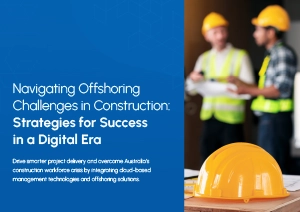Navigating Offshoring Challenges in Construction: Strategies for Success
in a Digital Era
Drive smarter project delivery and overcome Australia’s construction workforce crisis by integrating cloud-based management technologies and offshoring solutions.
Executive Summary
Australia’s construction industry faces unprecedented challenges: chronic labour shortages, escalating costs, and high rates of burnout threaten productivity and growth. Forward-thinking companies are increasingly turning to offshoring as a strategic solution, combining global talent acquisition with cloud-based construction management systems to maintain competitiveness in this challenging landscape.
The results speak for themselves: reduced overheads, enhanced project control, and improved team productivity across all stages of construction. By strategically filling key roles with offshore professionals while leveraging cloud platforms to maintain seamless project management, construction firms are creating more responsive, cost-effective operations without stretching limited local resources.
Introduction
The Australian construction sector is at a critical crossroads. With workforce shortages rapidly intensifying, traditional solutions such as domestic hiring and skilled migration programmes have proven insufficient to meet industry demands. A more innovative approach is required: integrating offshore professionals into key roles and utilising digital collaboration tools to maintain project momentum, quality standards, and business continuity.
This analysis explores both the challenges facing the construction industry and presents compelling solutions, with particular focus on how strategic partnerships with offshoring firms can help construction companies not merely survive but thrive amid these industry pressures.
The Workforce Shortage: A Growing Gap the Industry Can’t Ignore

130,000
new construction professionals are needed in Australia
The scale of Australia’s construction labour shortage is massive. Master Builders Australia projects a need for an additional 130,000 workers over the next five years to meet growing construction demand, excluding the replacement of over 100,000 workers leaving the industry annually. This shortage is compounded by an ageing workforce, rampant workers’ burnout, and limitations within the skilled migration system.
These deficits span across multiple occupational categories. The 2024 Infrastructure Market Capacity Report identifies current shortages:
(56% of total shortage)
(15% of total shortage)*
Aggravating these staffing challenges, workforce productivity declined to -0.8% in 2023, driven by factors including inadequate project documentation, poor document control, and ineffective scheduling and planning. These deficiencies force skilled professionals to handle administrative tasks rather than focusing on strategic planning and problem-solving, further eroding productivity.
The Strategic Shift to Global Collaboration
As economic challenges mount and the local workforce contracts, Australian construction companies are increasingly embracing offshoring as a strategic necessity. Countries like the Philippines offer more than mere cost advantages. They provide access to a substantial talent pool of qualified professionals ready to enhance operational quality and efficiency.
Offshoring presents a practical solution to workforce shortages while complementing technological advances in project management. Approximately half of surveyed construction companies believe that modernisation in project management, design, and planning processes will significantly impact workforce productivity.
The integration of cloud-based construction management platforms is particularly transformative, revolutionising how projects are planned, executed, and monitored. These digital tools enable:
Together, offshoring and cloud-based management systems offer a comprehensive solution to the modern challenges in Australia’s construction industry—addressing both the human resource gap and the technological demands of contemporary project delivery.
Turning Offshoring Challenges into Strategic Advantages
While offshoring construction roles delivers transformative benefits, understanding and addressing potential challenges is essential for maximising return on investment. The following challenges, when properly managed, actually become strategic advantages that strengthen a construction firm’s competitive position.

Quality Control and Consistency
Challenge:
Whether onshore of offshore, ensuring quality and consistent information across geographically dispersed teams remains a primary concern. Traditional construction methods often leave field personnel working with outdated information, leading to costly errors. A past report by FMI cited by Autodesk revealed that construction professionals spent roughly 35% of their time on unproductive activities like resolving information conflicts.
Strategic Solution:
Cloud-based construction management systems transform this challenge into an opportunity by creating a single source of truth (SSOT) accessible to all team members, regardless of location. By implementing robust quality assurance processes through integrated digital platforms, offshoring improves quality and consistency.
Data Security and Compliance
Challenge:
When outsourcing critical tasks involving sensitive project data, legal and regulatory compliance becomes paramount. Managing proprietary information across international boundaries requires navigating multiple regulatory frameworks, including both Australian requirements and overseas regulations like the Philippine Data Privacy Act.
Strategic Solution:
Leading cloud-based systems offer enterprise-grade security that often exceeds what many construction firms maintain internally. These platforms provide comprehensive protection including:
Time Zone Differences and Project Management
Challenge:
While offshoring opens doors to a wider talent pool, differences in time zones can complicate project coordination and delay critical decision-making. Proximity should therefore be a key consideration when selecting an offshore location.
Strategic Solution:
Offshoring to the Philippines provides Australian construction firms with a practical advantage: a minimal time difference of just 2–3 hours from Australia’s eastern states. This allows for seamless overlap between teams, enabling extended operational hours without major disruptions to standard work schedules. Filipino offshore staff can align their work hours with Australian time zones or maintain Philippine hours to create an extended work cycle. This flexibility makes real-time collaboration easier and enhances responsiveness across all project stages.
When implemented with robust project management practices, such as regular check-ins and clear reporting structures, this strategy ensures that all parties remain aligned on project milestones and quality objectives.
Cloud-based project management platforms further strengthen this strategy by enabling:
Time Zone Differences and Project Management
Challenge:
Construction firms need to maintain operations even during local disruptions or emergencies that might affect their primary workforce or facilities. At the same time, outsourcing to other countries requires careful consideration of natural disasters and other regional risks that may affect offshore teams.
Strategic Solution:
Leveraging offshore teams can significantly enhance operational reliability by providing built-in redundancy. When local emergencies disrupt business in Australia, key roles and functions can continue seamlessly from offshore locations, following well-defined contingency plans. Additionally, partnering with outsourcing providers like Twoconnect—that have dedicated Crisis Coordination Committees—ensures proactive management of disruptions in the offshore region, maintaining stability and business continuity on both fronts.
The Emergence of Cloud-Based Construction Management
The construction industry is increasingly adopting cloud-based solutions to manage complex projects more efficiently. These platforms are driving a shift from traditional project management methods, enabling better collaboration, faster information access, and improved decision-making. As more teams transition to these tools, they discover the immense value of real-time updates and integrated workflows that streamline project execution.
What Is Cloud-Based Construction Management?
Cloud-based construction management refers to the use of online platforms that allow project teams to store, manage, and share project data in real time. Some key functionalities include document management, task scheduling, budget tracking, and communication tools.
Comparison of Key Platforms
Cloud-based construction platforms may share core functionalities like document control and real-time updates, but each one brings something unique to the table. Here’s a side-by-side comparison of some of the industry’s most widely used tools.
| Platform | Key Features |
| Procore | All-in-one project management with tools for scheduling, budgeting, RFIs, and drawing management |
| Autodesk Construction Cloud | Combines design coordination, field collaboration, and cost controls in one connected environment |
| PlanGrid | Mobile-first field collaboration, easy markup tools, and document version control |
| Buildertrend | Built for residential and small commercial projects with features for client portals, selections, and job costing |

Key Benefits of Using Cloud-Based Construction Management Platforms
Cloud-based construction management systems address long-standing industry pain points through several core advantages:
The wider adoption of cloud-based platforms helps construction firms tackle persistent challenges across projects of all sizes. These tools do not merely store information—they connect workflows, teams, and decisions in ways traditional systems cannot. When project data flows seamlessly between phases and stakeholders, teams gain greater control over quality, timelines, and budgets.
This connected approach is proving essential in driving better outcomes across the Australian construction lifecycle, with businesses reporting significant improvements after adopting cloud-based platforms. For instance, companies have seen up to 60% time savings on administrative work including estimating, invoicing, and scheduling. Productivity also increased by 34% due to the implementation of new cloud technologies. Overall, these efficiencies resulted in revenue growth for 61% of construction companies. This growth is attributed to the ability of cloud platforms to streamline operations and reduce costs by automating administrative tasks, improving project delivery through enhanced communication and real-time data access, and enabling better resource management.
How Offshoring and Cloud-Based Management Empower Construction Projects
Cloud-based construction platforms already offer a major step forward in improving visibility, collaboration, and decision-making. When paired with offshoring, these tools become even more powerful, creating a model that’s not only more efficient, but also more scalable and resilient across all stages of construction. Here are some benefits construction companies may experience:
1. Cost Efficiency in Digital Transformation
Adopting new technologies can be costly, but offshoring makes digital transformation more financially sustainable. Offshore teams can provide cost-effective support for IT infrastructure, software maintenance, and system rollouts. Instead of stretching onshore resources thin, companies can rely on offshore professionals to manage upgrades, troubleshoot issues, and maintain cloud-based tools, keeping systems running smoothly without high overheads.
2. Seamless Data Management
Cloud platforms offer centralised data access, which offshoring amplifies. Offshore teams can handle critical data tasks including entry, updates, and analytics in real time, ensuring platforms reflect the most current project status. As offshore teams maintain cloud-based data, managing and validating documentation, ensuring updates are properly logged, and assisting with compliance tracking, the likelihood of outdated drawings and missed revisions is reduced.
3. Improved Collaboration and Productivity
Offshoring provides continuous support that enhances collaboration across field crews, office staff, and subcontractors regardless of time zone. With team members working within a cloud-based platform, real-time updates to project data reduce miscommunication. Offshore staff can monitor workflows, flag urgent issues, and promptly notify the right stakeholders, enabling faster decision-making and conflict resolution. This keeps projects moving forward even outside standard business hours, boosting overall productivity.
4. Faster Turnaround for Quotes, Bids, and Project Execution
Cloud-based collaboration tools streamline workflows by reducing bottlenecks, while offshore support adds a critical speed advantage. With the flexibility to let offshore teams handle tasks after Australian hours, project management and documentation progresses around the clock. Project scoping, quote preparation, and quality assurance proceed at a faster rate. By the time onshore teams start their day, key deliverables are already in motion, enabling faster responses to bids and approvals. This continuous workflow shortens the project timeline from planning to execution and enhances productivity, giving construction firms a tangible competitive edge in fast-paced markets.
5. Greater Scalability and Flexibility
As project demands grow or change, offshoring allows construction firms to scale their workforce without the delay or cost of expanding local headcount. Offshore staff can be quickly onboarded to support various functions, from Building Information Modeling (BIM) coordination and document control to procurement support and cost tracking, allowing firms to respond to changing workloads with agility.
Leveraging Offshore Teams for Key Construction Functions
Offshoring companies like Twoconnect provide access to experienced professionals in the Philippines, enabling construction firms to expand their capabilities across design, coordination, and cost planning functions. These offshore roles fill workforce gaps and keep cloud-based systems up to date, aligned, and running smoothly.
Key roles that Australian companies can successfully offshore to the Philippines include:
Success Stories and Real-World Applications
Real-world examples continue to prove the value of integrating offshoring into construction operations, especially when combined with smart digital solutions. One notable success is Evoke Projects, a Sydney-based interior design and fit-out company serving workplace, education, healthcare, and veterinary sectors.
Evoke Projects
Faced with rapid business growth and rising operational complexity, Evoke needed specialist talent without overextending local resources. Twoconnect helped identify and recruit highly skilled offshore professionals for critical roles, including Estimators, Interior Designers, a Finance Officer, and a Marketing Administrator. These team members seamlessly integrated into Evoke’s ISO-certified processes, handling vital responsibilities while freeing local staff to focus on core project delivery.
Evoke’s experience highlights the long-term value of a well-managed offshore strategy. When paired with cloud-based platforms, offshoring empowers construction companies to scale quickly, improve output quality, and achieve operational excellence without sacrificing flexibility or control.
The results of Evoke’s partnership with Twoconnect remarkably increased productivity from all departments.
Evoke projects also gained:
70%
cost savings on annual expenses
100%
revenue growth over a 2-year period
Core Consulting Engineers
Core Consulting Engineers, a leading construction consulting firm, also successfully integrated offshoring into their operations through a strategic partnership approach. By collaborating with Twoconnect, they enhanced their team with specialised talent from the Philippines, filling critical positions including a Remedial Drafter, Mechanical Engineer, and Accounts & Administration Officer.
Best Practices for Successful Offshoring in Construction
When selecting an offshoring partner, construction firms should ensure their chosen provider follows this comprehensive process to deliver successful outcomes:
1. Strategic Foundation
The offshoring company should:
2. Talent Acquisition
Verify that their recruitment approach:
3. Onboarding and Integration
Confirm that they provide:
4. Performance Management and Operational Support
Verify their commitment to:
Some offshoring providers offer managed services that provide comprehensive support throughout the full lifecycle offshoring. When combined with structured reporting and continuous integration, this approach can improve onboarding and increase offshore staff retention.
By partnering with providers that follow these best practices, construction firms can stay focused on their core business while fully integrating offshore specialists without losing visibility or control over their remote operations.
Future Outlook: The Next Phase of Construction Offshoring
The construction industry is in the process of major change, driven by rapid advances in digital tools and data capabilities. As this shift continues, offshoring is set to move beyond its traditional support role and become a more integral part of how projects are delivered from early design to post-construction insights.
The industry is already seeing signs of this. Roles once limited to drafting and coordination are evolving into more complex, high-value functions. Offshore professionals are now contributing to AI-powered design reviews, automated quantity take-offs, clash detection within BIM environments, and data-led risk forecasting. This shift will only accelerate as firms look to build smarter, faster, and with fewer errors.
To stay competitive, construction firms will need offshoring partners that offer more than talent placement. They’ll need teams who understand the latest platforms, adapt quickly to evolving workflows, and help drive innovation—not just keep up with it. Twoconnect is already investing in this future, upskilling talent in advanced tools and working closely with forward-leaning clients to shape what’s next for global construction.

Conclusion: Building Resilience Through Strategic Offshoring
As Australia’s construction businesses stand at a crossroads, the path to sustainable growth lies in the strategic combination of offshoring and cloud-based construction management tools. This integrated solution goes beyond filling workforce gaps––it provides a comprehensive framework for operational excellence.
Companies that leverage this approach gain the ability to sustain project momentum, scale efficiently, maintain business continuity, and respond with greater agility to market demands while upholding rigorous quality standards. Offshoring, when implemented with cloud-based platforms, gives constructions firms significant operational advantages throughout the project lifecycle: higher productivity, faster turnaround times, greater cost efficiency, and seamless collaboration across time zones.
As the industry shifts toward more complex, tech-driven delivery models, the strategic value of offshoring will only expand. Firms that take action now by building the right partnerships, processes, and platforms will not only solve today’s workforce challenges but also future-proof their operations for the digital evolution ahead.
Offshoring will continue to play a critical role in the evolution of healthcare as digital health solutions, such as telemedicine, wearable devices, and remote monitoring, redefine how care is administered. Offshore teams are integral in contributing to these innovations by providing skilled professionals capable of managing the operational demands of these new technologies.
References:
- 1Twoconnect Editorial Team (https://www.twoconnect.com.au/; 2025) Offshore Outsourcing: Fixing Australia’s Talent Shortage. The blog talks about the ongoing talent shortage in Australia and how outsourcing can help.
- 2
Grace Ellis (https://www.autodesk.com/; 2024) Why Cloud-Based Construction Management Technology is the Future. The article discusses the effect of cloud-based construction management technology and how it positively impacts most construction companies.
- 3Autodesk Editorial Team (https://www.autodesk.com/; 2018) The High Cost of Poor Data and Miscommunication in Construction [Report]. The report talks about findings of the 2018 Construction Disconnected report, revealing the costs of poor data and miscommunication in construction and the challenges of effectively deploying technology to address these issues.
- 4
Buildertrend Editorial Team (https://buildertrend.com/; 2022) Cloud Construction Software Guide. This blog outlines the key advantages of using cloud-based software for construction businesses.
- 5
Twoconnect (https://twoconnect.com.au/) Case Study: Evoke Projects – Twoconnect. This page presents a case study of Evoke Projects, detailing their successful collaboration with Twoconnect for offshore staffing in the Philippines
- 6
Twoconnect (https://twoconnect.com.au/) Outsource Engineering and Construction Services. This page discusses Twoconnect’s services for outsourcing construction and engineering roles to the Philippines
- 7
Infrastructure Australia (https://www.infrastructureaustralia.gov.au/; 2024) Infrastructure Market Capacity 2024 Report. The report examines the country’s infrastructure pipeline and highlights key challenges and strategies to improve workforce capacity, manage rising costs, and boost construction productivity.
- 8
Master Builders Australia (https://masterbuilders.com.au/; 2024) The Future of the Workforce: The Building and Construction Industry. This report outlines strategies to address critical labour shortages in the construction industry .
- 9
Tradiepad. (https://www.tradiepad.com.au/; 2023) Digital Adoption in the Construction Industry. This blog explores how cost and operational benefits of adopting digital tools in Australia’s construction industry.
Ready to offshore? Let’s connect!
Submit your contact details below and our expert consultants will respond to your enquiries right away.
